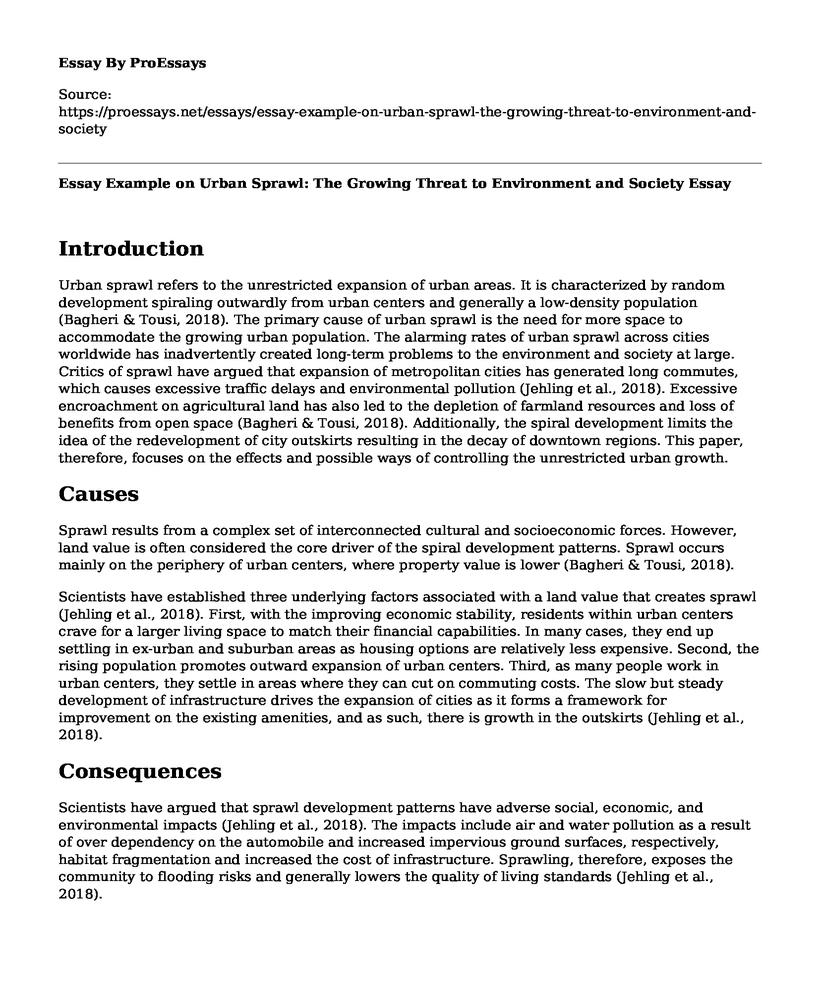Introduction
Urban sprawl refers to the unrestricted expansion of urban areas. It is characterized by random development spiraling outwardly from urban centers and generally a low-density population (Bagheri & Tousi, 2018). The primary cause of urban sprawl is the need for more space to accommodate the growing urban population. The alarming rates of urban sprawl across cities worldwide has inadvertently created long-term problems to the environment and society at large. Critics of sprawl have argued that expansion of metropolitan cities has generated long commutes, which causes excessive traffic delays and environmental pollution (Jehling et al., 2018). Excessive encroachment on agricultural land has also led to the depletion of farmland resources and loss of benefits from open space (Bagheri & Tousi, 2018). Additionally, the spiral development limits the idea of the redevelopment of city outskirts resulting in the decay of downtown regions. This paper, therefore, focuses on the effects and possible ways of controlling the unrestricted urban growth.
Causes
Sprawl results from a complex set of interconnected cultural and socioeconomic forces. However, land value is often considered the core driver of the spiral development patterns. Sprawl occurs mainly on the periphery of urban centers, where property value is lower (Bagheri & Tousi, 2018).
Scientists have established three underlying factors associated with a land value that creates sprawl (Jehling et al., 2018). First, with the improving economic stability, residents within urban centers crave for a larger living space to match their financial capabilities. In many cases, they end up settling in ex-urban and suburban areas as housing options are relatively less expensive. Second, the rising population promotes outward expansion of urban centers. Third, as many people work in urban centers, they settle in areas where they can cut on commuting costs. The slow but steady development of infrastructure drives the expansion of cities as it forms a framework for improvement on the existing amenities, and as such, there is growth in the outskirts (Jehling et al., 2018).
Consequences
Scientists have argued that sprawl development patterns have adverse social, economic, and environmental impacts (Jehling et al., 2018). The impacts include air and water pollution as a result of over dependency on the automobile and increased impervious ground surfaces, respectively, habitat fragmentation and increased the cost of infrastructure. Sprawling, therefore, exposes the community to flooding risks and generally lowers the quality of living standards (Jehling et al., 2018).
Sprawl Reduction Policies
Although the causes and effects of sprawl are quite overwhelming, procedures can be established to control the unsustainable growth patterns. Planning policies can help local communities to develop ecologically sustainable land use. Compact development policies can help in restricting population growth within a particular region hence controlling sprawling into rural areas (Bagheri & Tousi, 2018).
Policymakers can also select and implement specific sprawl reduction strategies. For instance, fragmentation regulations, land development prescriptions, urban growth boundaries, and building permit limits can restrict growth to the desired locations. Incentive-based techniques such as developing density bonuses and house clustering can also be employed to encourage controlled development in regions within the city centers. Besides, infrastructure-based policies such as phasing of development, targeted public investments, and land purchasing procedures can enable governments to acquire and secure ecologically critical areas (Jehling et al., 2018). Also, educating the public on the adverse effects of sprawl can be paramount in the campaign.
Conclusion
Urban sprawl management policies can help achieve sustainable development. Proper urban planning can result in reduced costs of infrastructure, cleaner resources: water and air, protected natural systems, and improved quality of life.
References
Bagheri, B., & Tousi, S. N., (2018). An explanation of the urban sprawl phenomenon in Shiraz Metropolitan Area (SMA). Cities, 73, 71-90. Retrieved from: https://www.sciencedirect.com/science/article/pii/S0264275117305929
Jehling, M., Hecht, R., & Herold, H. (2018). Assessing urban containment policies within a suburban context-An approach to enable a regional perspective. Land use policy, 77, 846-858. Retrieved from: https://www.sciencedirect.com/science/article/pii/S0264837716305580
Cite this page
Essay Example on Urban Sprawl: The Growing Threat to Environment and Society. (2023, Jan 11). Retrieved from https://proessays.net/essays/essay-example-on-urban-sprawl-the-growing-threat-to-environment-and-society
If you are the original author of this essay and no longer wish to have it published on the ProEssays website, please click below to request its removal:
- Statement of Philosophy for Working with Families and Communities
- Essay Sample on Difference Between Cliques and Crowds
- Essay on Bullying Within Friendships: An Analysis of Victimization Among Peers
- Parenting: Responsibility, Values and Character Building - Essay Sample
- Divorce Rates: Causes & Solutions for Strengthening Families - Essay Sample
- Essay Sample on Marco's Father Making Decisions: Dilemma for Marco
- Social Work Ethics and Values Essay Example







